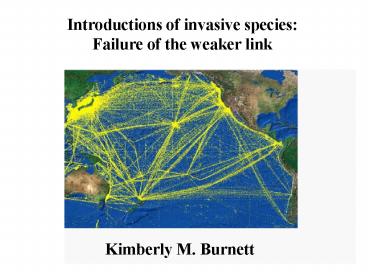Lessons - PowerPoint PPT Presentation
1 / 18
Title:
Lessons
Description:
Prevention in 1 place is prevention in another ... Costs comparative statics: Ex ante analysis. Absolute cost values or difference? ... – PowerPoint PPT presentation
Number of Views:31
Avg rating:3.0/5.0
Title: Lessons
1
Introductions of invasive species Failure of
the weaker link
Kimberly M. Burnett
2
Prevention of invasions as a public good
- Prevention in 1 place is prevention in another
- Doing inspections, regulations, monitoring,
quarantines, etc. - ? less likely species will invade
- ? less likely to invade other regions (esp. if
shared borders, - lots of trade between places)
- Examples
- West Nile in HI
- Yellow star thistle
- Zebra mussels
3
Prevention of YST
AR?
MS?
2005 map http//plants.usda.gov
4
Prevention of Zebra Mussels
GA?
FL?
2003 Map USGS
5
Special kind of public good
- The exclusion and control of invasive species is
a weakest link public good (Perrings et al.
2002) - Hirshleifer (1983,1985) introduced weakest link
public goods (levy example) - Weakest link implies the following aggregation
technology
6
Prevention as weaker link
- Own prevention helps, even if others do less
- Prevention beyond lowest level provides benefit,
but progressively less as exceed min - Public good aggregation given by geometric mean
- (Cornes 1993)
- If 2 regions,
- What this means is regions have incentive to know
what other will provide, since better off if
dont provide more. May or may not know.
7
Prevention based on cost
Costs can represent technological, institutional,
political, environmental, etc. differences, e.g.,
heterogeneous environments (diversity, islands
vs. continents, etc.)
Easier to invade, high cost
Harder to invade, low cost
8
Objectives
- Use weaker link public good model to describe
prevention of invasive species - Compare equilibrium prevention levels to
efficient levels - Investigate how the structure of information
between regions (regarding cost of prevention)
changes this
9
Model
2 region, static, utility maximization
cH with probability ?
2 cost types
cL with probability (1-?)
- Solve compare
- PO levels of prevention (Social planner)
- Complete information equilibrium (NEq)
- Incomplete information equilibrium (BNE)
10
Results Underprovision of prevention
- PO prevention gt NEq (complete info) prevention
- PO prevention gt BNE (incomplete info) prevention
- ? In equilibrium, prevention of
invasive species will be
underprovided compared to the
efficient level - How does NEq compare to BNE?
11
Complete vs. incomplete information
12
Deviation function
- Need to look at expected difference between
complete and incomplete information
13
Ex ante analysis
- Value of this function is positive given any ?,
cH, cL - ? More prevention expected to be provided under
- complete information
- Costs comparative statics
14
Absolute cost values or difference?
15
Ex post analysis
- Numerical analysis
- After types are realized, how do provision levels
compare? - Result anything can happen
- Under some specifications of ?, incomplete
information more efficient
16
Lessons
- Prevention of invasive species will be
underprovided in equilibrium compared to the
efficient level - Ex ante, incompleteness of information leads to
inefficiently low levels of prevention - Ex post, possible that incomplete information
more efficient
17
Implications and extensions
- Complete information more efficient make costs
transparent (improved reporting, communication).
We see this happening (GISP, NISC, NBII, ISSG) - Costs closer together higher efficiency
Pareto-improving transfers from low cost to high
cost countries? - As a first step, focused on how weaker link
technology affects equilibrium prevention - More complete model would include type of
prevention activity, income/preferences,
probability of invasion.
18
Thanks to USDA/ERS (43-3AEM-3-80083)
University of Hawaii Arts and Sciences Advisory
Councilfor financial support































